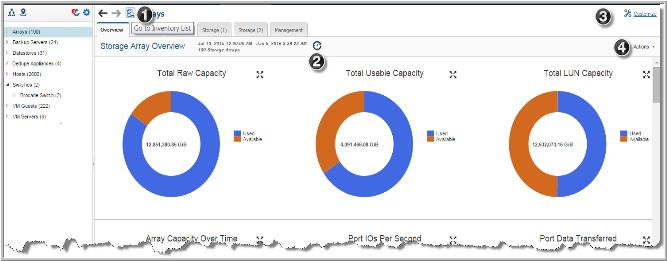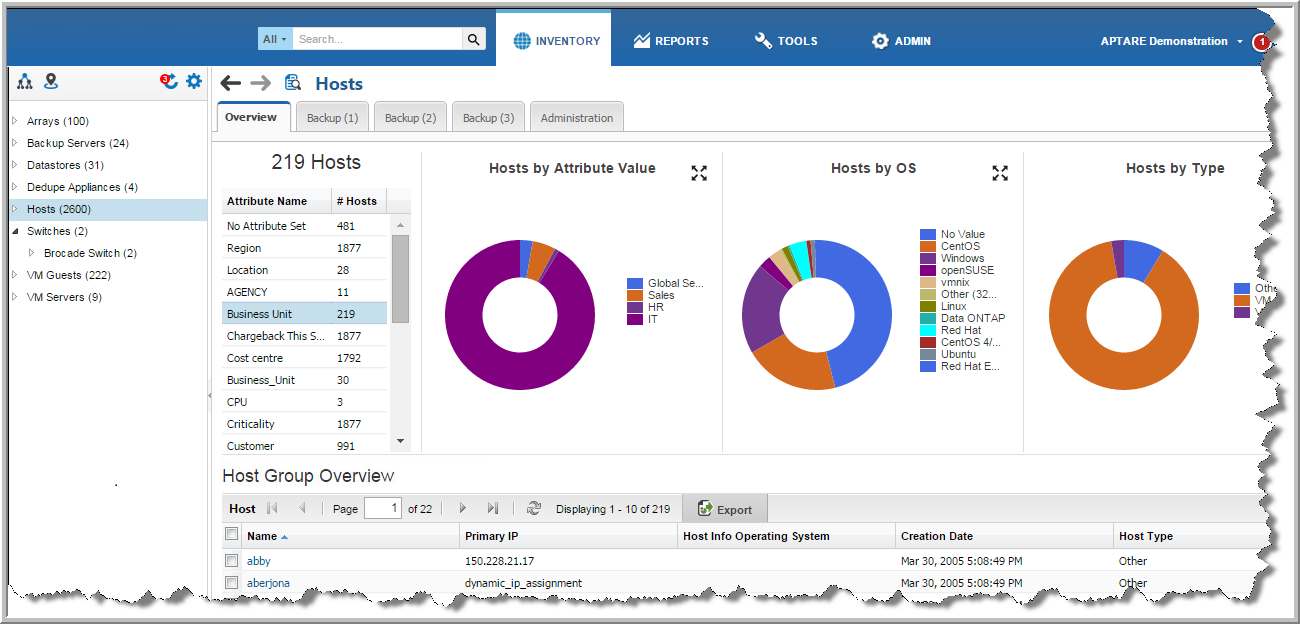Working with the Inventory Reports View
Each inventory object category is associated with a default set of reports. Groups with more than one object type do not have reports.
You can select what reports you want to readily access, by customizing an item’s set of pages. These reports offer relevant data for the selected category and are displayed as tabs across the top of the Inventory view. They are sorted into information categories such as performance, storage or forecasting. The report list is controlled by privileges and license restrictions.
A summary page, when available, is displayed by default for each object and category.
The Inventory Reports view enables you to:
1. Toggle between the Inventory List and Inventory Reports.
3. Click Customize to select the reports to display in tabs.
4. Click
Actions to access the standard report functionality.

See also:
Accessing Inventory Reports
1. Click Inventory.
2. Select an object category or navigate to a single object in the Hierarchy Panel.
3. Click Go to Inventory Reports to toggle to the list of inventory objects within the category. An interactive summary page, when available, is displayed by default for each object or category.
Selecting Reports Using Customize
Your selections are displayed as tabbed functional categories in the Inventory Reports view.
1. Click Inventory.
2. Choose a category.

3. Click Customize. A list of reports is displayed. The report list is controlled by privileges and license restrictions.
5. Click
Save. Your selections are displayed as tabs in the
Inventory Reports view.

Searching within Available Reports
If you are looking for a specific report name or description within the list of Available Reports, enter the value to refine the list. This search examines report names and descriptions. The list of Available Reports is controlled by privileges and license restrictions.
1. Enter a value into the
Search field.

2. Click the Search icon. The Available Reports list is filtered to display only the reports that contain the specified value.
Inventory Reports and the Action Menu
Many functions available to standard reports and templates are available to the reports in the Inventory Navigator.
• Inventory Reports: Edit Scope - Your selection in the Hierarchy Panel sets the objects which are part of the scope. For some objects and object groups, you can edit additional parameters.
Edit Scope is only shown when there are parameters available to change. A default time period is also set for those reports that require one. Use the Hierarchy Panel to revise the scope when the menu item is not displayed. See
Report Scope for details.
• Inventory Reports: Save As - When you save a report, you are saving a copy of the report into the
Reports tab,
not the report output. You can save a version in your Report folders. See
Saving Reports for details.
Note: Some reports provided by the Inventory are specialized and not available from the Reports tab. Due to the nature of these reports, they function like Detail reports and cannot be customized or saved, as they are specific to the report from which they were derived. Save As is not displayed for these reports.
• Inventory Reports: Email - After you generate a report and it renders, you can choose to instantly email the report. Emailed reports are not derived from the cache. These events are run in real-time, so current data is always used. You can email a report to yourself, other individuals, or a distribution list. Scheduling reports to be regularly emailed is not available from the
Inventory tab. See
Emailing Reports and Dashboards for details.
• Inventory Reports: Export - You can export reports to make them available to external applications, such as Microsoft Excel or if you’d like to generate a hardcopy, you can export them to a file, such as a PDF. Exported reports are not derived from the cache. These events are run in real-time, so current data is always used. See
Exporting Reports and Dashboards for details.
• Inventory Reports: Filter - In addition to the filtering that happens with your hierarchy selection, table-formatted reports can be further filtered on Rows and/or Columns, using advanced filtering. You can define the criteria for the data rows displayed in a report. Drop-down lists enable selections from the available columns. Next, you supply the operator—such as
equals or
does not contain—and a value for that column. Up to 16 selections can be joined to form the filter. See
Advanced Filtering for Tabular Reports for details.







